Guard on Compliance | Misty Guard
‘Lead-free certified’ compliance date approaches
Covered products must be lead-free certified, through third-party or self-certification, by Sept. 1.

fizkes/iStock/Getty Images Plus via Getty Images
With the August heat in full force, here's hoping you can cool off in a local pool, under the shade of a leafy tree, or even within the spray of a backyard sprinkler. And as summer nears its end and fall approaches, may you seize the chance to enjoy camping, travel or friendly barbeques. There's still time to make some special memories!
We should discuss an important deadline coming up early next month. It's the compliance date for third-party certification or self-certification, also known as "lead-free certified," to the Safe Drinking Water Act (SDWA) Section 1417 and codification of the Reduction of Lead in Drinking Water Act of 2011 (RLDWA) for lead in plumbing fittings, plumbing fixtures, pipe fittings, pipes, solder, flux and custom fabricated products. There's a lot to discuss, so let's jump right in.
What is the deadline for covered products to be lead-free certified?
The deadline is Sept. 1, 2023.
Who must comply?
There are two entity groupings used in the lead-free regulations: 1) those who offer products for sale or distribution in the United States (U.S.), known as introduction into commerce, and 2) those who are associated with the installation or repair of plumbing systems.

What business activities are prohibited?
The following business activities are prohibited in the U.S.:
- Businesses may not offer any covered product for sale or distribution that exceeds the lead-free maximum limit.
- Businesses, installers and plumbers may not use covered products that exceed the lead-free maximum limit for the installation or repair of:
a. any public water system;
b. or any plumbing that provides water for human consumption in residential or nonresidential facilities. - Plumbing supply businesses may not sell solder and flux exceeding the lead-free maximum limit.
- Businesses, excluding manufacturers, may not offer solder and flux for sale or distribution exceeding the lead-free maximum limit without a prominent label stating that it is illegal to use the solder or flux in installing or repairing any plumbing providing water for human consumption.
What are the lead-free maximum limits?
"Lead-free" doesn't mean zero lead in covered products. Instead, "lead-free" means covered products have less than the maximum allowable lead limit. In 1986, the concept of lead-free maximum limits were introduced, with modifications in 1996, 2011, and 2020. In 2020, the U.S. Environmental Protection Agency (EPA) added:
- Custom fabricated products for all product families; and
- The inclusion of product-specific requirements, which is a deviation from the product family approach.
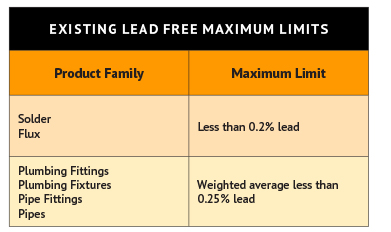
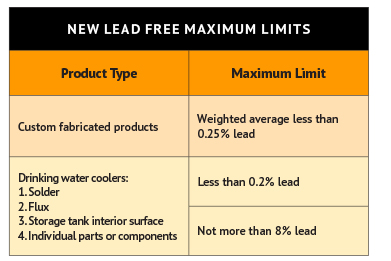
What are the covered products?
EPA provided product examples and clarified product family definitions. They have also added "custom fabricated products" under all product families as a regulated product type. Custom fabricated products are:
- Manufactured on a case-by-case basis for a single customer's unique needs;
- Not assigned a Universal Product Code (UPC);
- Not available through stocked inventory from a manufacturer, importer, wholesaler, distributor, retailer or other source for distribution; and
- Not marketed in catalogs, print marketing materials or on the internet.

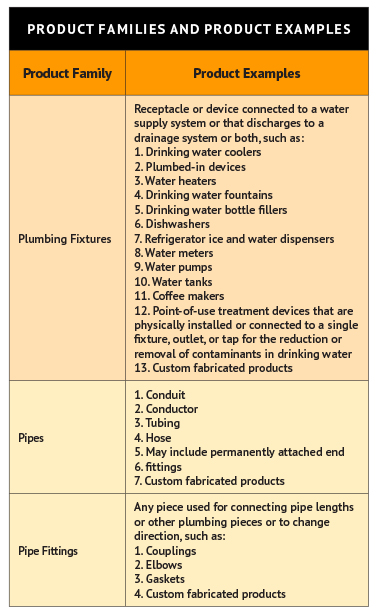
Which products and product uses are exempt?
EPA exempted an additional seven products and three product uses from the regulations to increase the number of exempted products and product uses to 26.
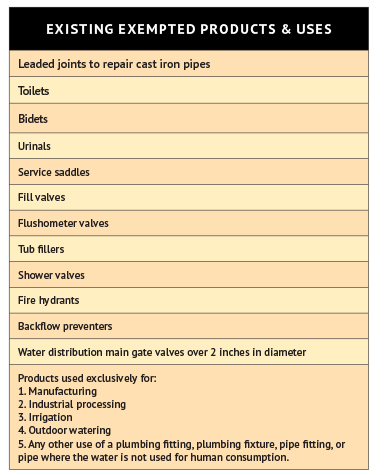
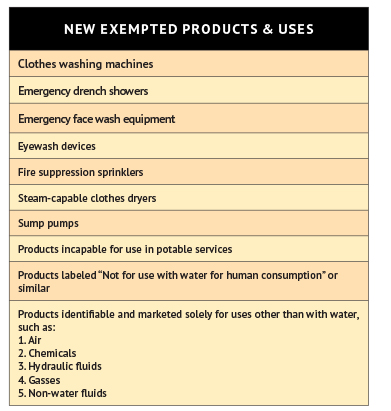
There's ongoing debate over what constitutes nonpotable uses versus potable uses. Additionally, many people fixate on "any other uses where water is not anticipated to be used for human consumption" as the key distinction between regulated and unregulated products. To clarify, EPA defined "potable use" (applicable only to this regulation subpart) as services or applications that provide water for human ingestion, such as for drinking, cooking, food preparation, dishwashing, teeth brushing, or maintaining oral hygiene. Additionally, EPA provided clarification of "used exclusively for nonpotable services" to include products 1) labeled "not for use with water for human consumption," 2) incapable for use in potable services, and 3) identified and marketed as being solely for a use other than the conveyance of water.
Does this mean you can label a product with "not for use with water for human consumption" and avoid the regulations? Not likely. EPA stated it's not enough to rely only on the primary nonpotable use of a product when the product could be anticipated for potable use. An example would be yard hydrants installed at campgrounds and R.V. parks for access to potable water used for cooking and drinking instead of for irrigation or outdoor watering nonpotable water use, which makes it a regulated covered product. EPA recommends manufacturers exercise caution when anticipating product use and consider multiple circumstances. Additionally, EPA recommends installers and plumbers verify the lead-free status of products used in system repairs and new installations. (85 FR 54235)
What is the method to calculate lead in a product?
In 2011, the RLDWA (P.L. 111-380) passed a methodology for calculating lead leaching for compliance with the lead-free maximum limits, known as the Weighted Average Lead Content (WALC) calculation. In 2020, EPA provided clarification on how to address unique product characteristics in the WALC calculation:
- Coatings and liners manufactured into pipes, fittings or fixtures must use the maximum lead content; and
- Media in filters, such as activated carbon or ion exchange resin, are excluded from being included in the total wetted surface area of the entire product.
How are products "lead-free certified"?
By Sept. 1, 2023, or before introducing a product into commerce, covered products must be "lead-free certified" for compliance with Section 1417 of the SDWA and the lead free maximum limits using the WALC calculation method in 40 C.F.R. 143. The following are exempt from individual certification:
- Product components of assembled pipes, fittings, or fixtures, if the final assembled end product is lead-free certified;
- Previously installed lead free certified, product-direct replacement parts, if the weighted average lead content of wetted surface area for the replacement part is equal to or less than the lead content of the original part; and
- Dishwashers.
There are two lead-free certification paths, dependent upon the number of manufacturer employees. Importers must obtain information from the manufacturer regarding the number of manufacturer employees. There are specific requirements for each lead free certification path, so be sure to review the regulations at 40 C.F.R. 143.
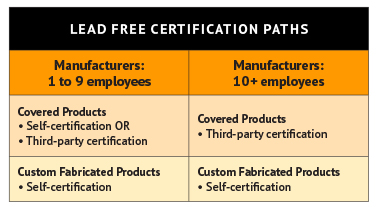
Which industry standard provides compliance to Section 1417 of the SDWA, lead-free maximum limits, and the WALC calculation method?
"While EPA supports the industry's voluntary use of a lead leaching standard and certification to that standard, a requirement for plumbing fittings and fixtures to be in compliance with it is not necessary or appropriate to implement section 1417 of the SDWA, because the requirement was specifically eliminated in the 2011 RLDWA." (85 FR 54235) Generally, the U.S. lead leaching standard is NSF/ANSI/CAN 372 Drinking Water System Components – Lead Content. The generally accepted practice is to use industry standards for compliance with regulations as long as the industry standard satisfies the minimum requirements of the regulation. However, NSF/ANSI/CAN 372 and the regulations differ in the areas of anticipated potable uses for covered products, in the clarification of media in filters for the WALC calculation, in the addition of lead free maximum limits for drinking water coolers, and in the selection of components, materials, and products for testing.
What can you do?
If you sell or offer products in the U.S., review your product lines for conformance with the regulations through verification of your third-party certifications for compliance with Section 1417 of the SDWA and lead-free maximum limits using the WALC calculation method in 40 C.F.R. 143. If you specify products or design, install or repair plumbing systems, verify that selected products meet the lead-free maximum limits by reviewing manufacturer-published literature, such as technical data sheets, installation manuals and website information.
Or, as always, simply simplify your life and call me at Regulosity! I can help.
Looking for a reprint of this article?
From high-res PDFs to custom plaques, order your copy today!








